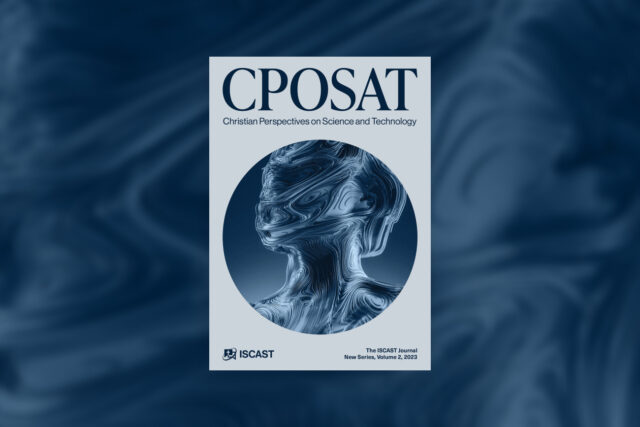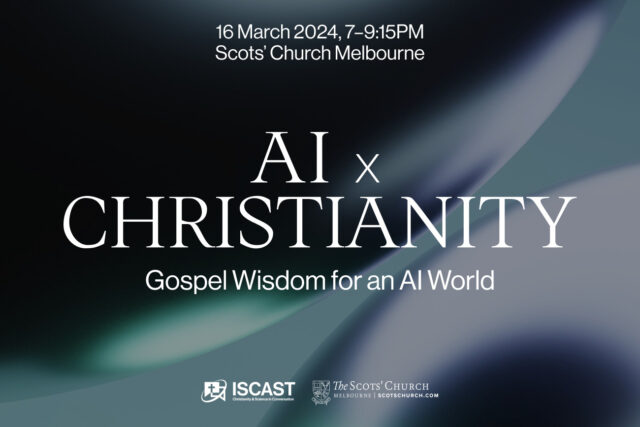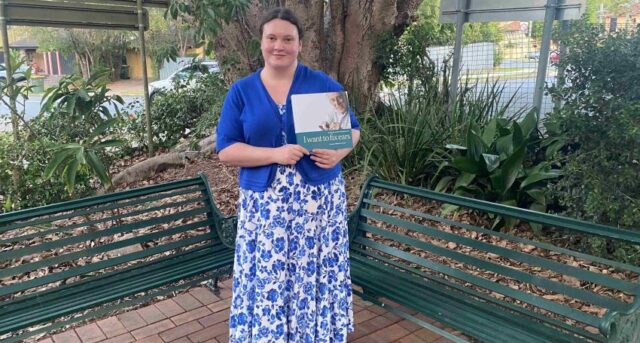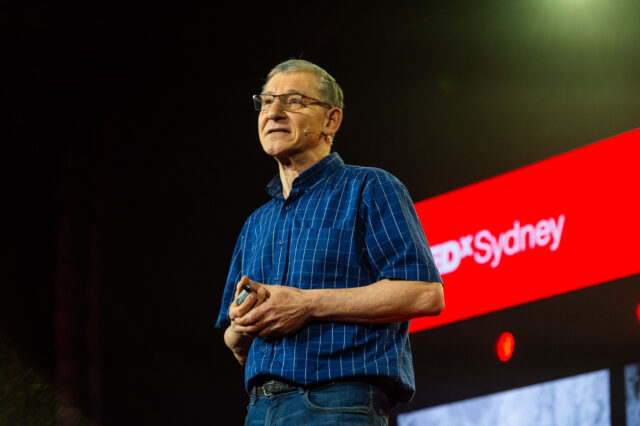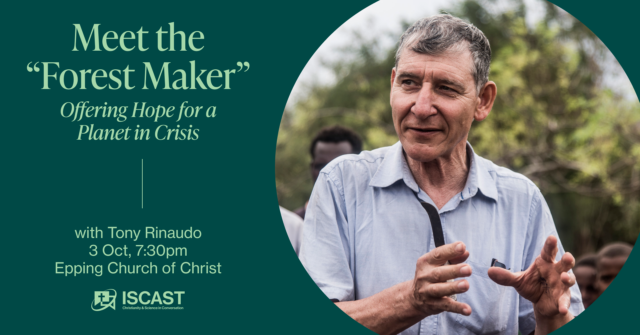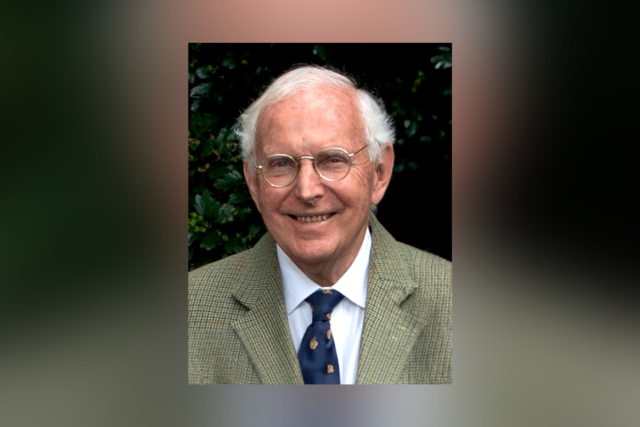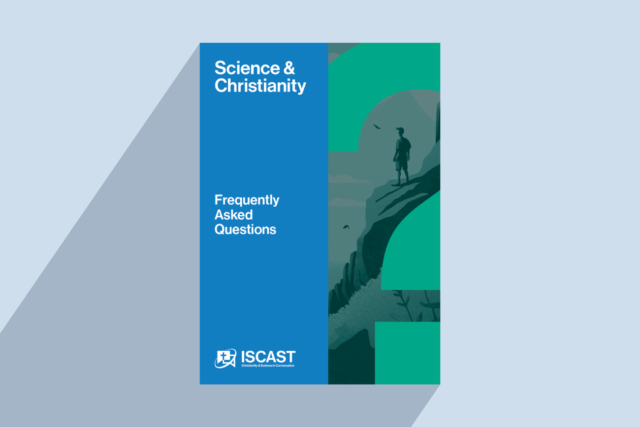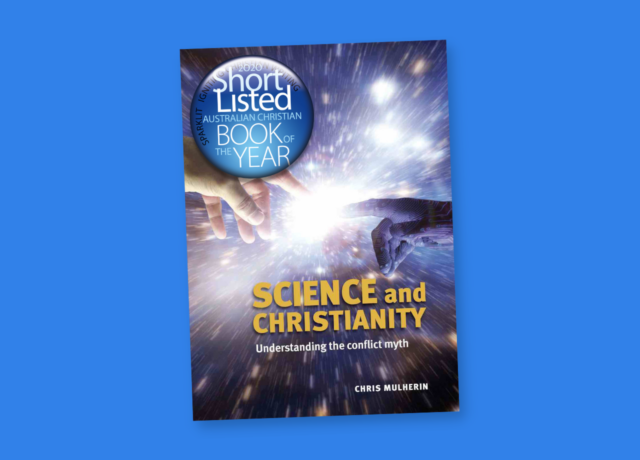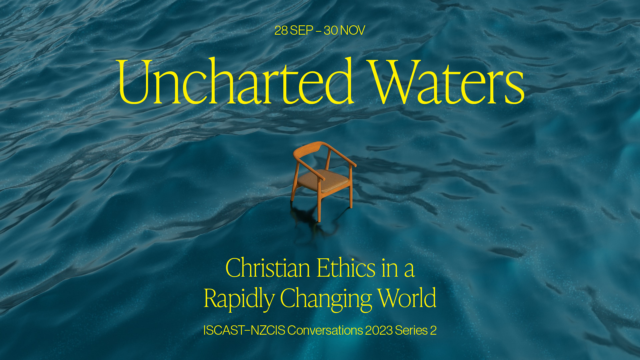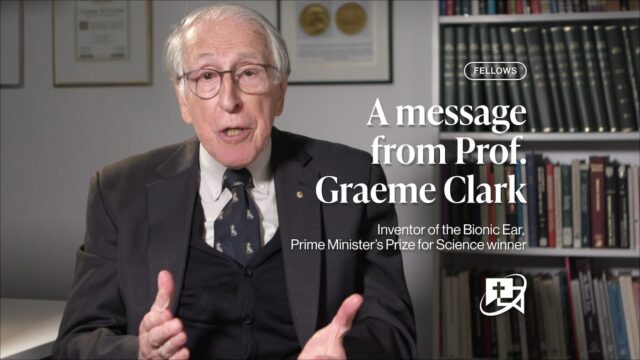


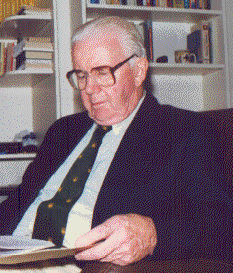
Allan Day on the science-faith interface (by John Pilbrow)
Reflections on the legacy of Allan Day in bioethics (by Denise Cooper-Clarke)
Allan, anthropology and the human person (by Alan Gijsbers)
May 2014
Download PDF
Authors
John Pilbrow
Emeritus Professor of Physics, Monash University, and Fellow and former President of ISCAST
Denise Cooper-Clarke
Voluntary researcher with ETHOS (Evangelical Alliance Centre for Christianity and Society), adjunct Lecturer in Ethics at Ridley Melbourne, and tutor in medical ethics at the University of Melbourne.
Alan Gijsbers
Assoc/Prof Gijsbers is a specialist physician in Addiction Medicine, an Honorary Clinical Associate Professor with the Department of Medicine Royal Melbourne Hospital, University of Melbourne, where he is the Head of the Addiction Medicine Service. He is also Medical Director of the Substance
Withdrawal Unit at the Melbourne Clinic, Richmond. He is also President of ISCAST.
John Pilbrow, Denise Cooper-Clarke and Alan Gijsbers
Emeritus Professor Allan Day, who died recently, was a distinguished physiologist who served as a Professor of Physiology at the University of Melbourne from 1967 to 1998. Allan was not only a leader in the Faith- Science conversation in Australia, but he also brought to the conversation many insights gleaned from attendance at international conferences and through the many significant friendships he made with some of the key players.
Allan had a vision for ISCAST, as a robust organisation of Christians prominent in science and technology, supplemented by broad-based theologians and philosophers. His vision also extended to the management of ISCAST, where his ideas initially bore fruit in Victoria from the late 1990’s and, more recently, at the national level now that ISCAST administration is contracted to the Company, Stockdale ACS.
The following tributes were presented at a meeting of ISCAST Victoria on November 23rd, 2013 by three people who knew Allan well. Their expertise helps shed light on different aspects of Allan’s contributions to Christian thought.
Allan Day on the science-faith interface
by John Pilbrow pp. 2–7
Reflections on the legacy of Allan Day in bioethics
by Denise Cooper-Clarke pp. 8–14
Allan, anthropology and the human person
by Alan Gijsbers pp. 15–20
It is the purpose of these three reflections to ensure that Allan Day’s legacy is not forgotten.
John Pilbrow
Emeritus Professor of Physics, Monash University, and Fellow and former President of ISCAST
This is an edited version of a presentation to the ISCAST Victoria Meeting on 23 Nov 2013.
Abstract
Emeritus Professor Allan Day (1927-2013) was a distinguished physiologist and noted Christian scholar, recognised as a leader at the science-faith interface. Allan Day was committed to a proper understanding of science within a biblical worldview, seeing that Christian faith and science provide complementary windows on the world. It was Allan’s vision that led to the 10 Lecture Ridley-ISCAST Course presented in 1997, 1999 and 2001. Another noteworthy contribution was his rebuttal of so-called Intelligent Design.
Key words
truth, complementarity, Big Bang, evolution, intelligent design, order
I was privileged to know Allan for some 45 years and I owe a debt of gratitude for his clear sightedness concerning how to interpret the interface between science and faith. I recall many hour long telephone conversations over many years and, in more recent years, many café lunch discussions, that continued until last year! We were fellow members of RSCF (Research Scientists’ Christian Fellowship) 1968-78 and ISCAST from 1992 until his death. I helped write an obituary which appeared in The Age on Nov 1st 2013. It can now be found at https://iscast.org/allan_day_obituary.
Allan Day was a Christian for most of his life. As an undergraduate, he served as President of the Adelaide University Evangelical Union. Allan was passionate about having a right understanding of science within a Christian view of reality. He was a man with four reasons to be called Doctor:- MBBS, MD, DPhil, DSc! In addition, in retirement, Allan added a BTh. He was a very highly qualified scholar.
There is no better place to find Allan’s views than in Notes on Science and Christian Belief (see https://iscast.org/notes_on_science_and_christian_belief) based on the 10 lecture ISCAST-Ridley College course presented in 1997, 1999 and 2001.
Influences
In expressing a personal faith in Christ and pursuing a scientific career he found himself in the company of many scientists both in the past and in the present who have found no problem in being both scientists and Christians. In particular I mention Prof. Malcolm Jeeves, a colleague at Adelaide University from 1959 to 1967, who had been active in the UK Research Scientists’ Christian Fellowship (RSCF) through the 1950s and who returned to the UK in 1969 to the University of St Andrews1.
I don’t think I ever asked whether he was a member of the Oxford RSCF during the mid-50s when engaged in his DPhil studies at Oxford. When I went to Oxford in 1961 I joined the group that was then coordinated by former ISCAST President, Professor John White.
Particularly during retirement years, Allan and Joan attended many conferences at the science-faith interface in the UK run by Christians in Science and the Ian Ramsey Centre in Oxford. During those years Allan honed his thinking by interacting particularly with John Polkinghorne, Arthur Peacocke and Prof Peter Hodgson, Oxford nuclear physicist and Catholic layman.
Passions
Allan was convinced that God is the author of all truth, scientific and biblical. Scientific truth is the truth about nature read in the ‘Book of nature’ while biblical truth is the truth about God read in the Scriptures. Thus, for Allan, there could be no conflict between the truths derived from the respective approaches. If there is apparent conflict he reasoned we need to look again at our interpretation of both.
Allan had a clear understanding that the development of modern science presupposed a God of order who created a world that was contingent on His will and therefore could be explored by experiment, not just discovered by reason alone. Allan consistently argued that there is no need for anyone to sacrifice intellectual integrity or to be embarrassed in having a Christian faith and in espousing a scientific approach to the world. Allan was committed to the unity of truth.
He was also aware that many of the early scientists were devout Christians, who saw their science as an expression of their faith, as a way of exploring God’s ways in nature. This object is expressed in the Charter of the Royal Society, the first of the major scientific societies, founded in 1662.
Allan was very widely read and he well understood how the dominance of a secular world view came about, particularly during the last 150 years. This development was not intrinsic to the nature or practice of science, but rather because of how it was perceived by many as a dominant (or even exclusive) way of knowing about the world.
1 Malcolm Jeeves also later served as President of the Royal Society of Edinburgh.
In summary, to Allan Day, faith and science were complementary and represented different windows on reality. Faith looks at the God of nature
— by Scripture. Science looks at the Nature of God — by creation. Thus we can be both Christian and Scientists.
Ridley-ISCAST Lectures on science and faith
Allan was the driving force behind the establishment of the 10-lecture course, first presented in 1997, jointly sponsored by Ridley College and ISCAST. Though Allan presented most of the lectures, he brought in three of us with expertise in areas outside biology and medicine:- Jonathan Clarke (philosophy of science, geology & geophysics), Ross Macmillan (environment) and myself (physics & cosmology).
An important motivation for the course was the need to address conceptual problems about the relationship of science and faith held by non-Christians, including secular humanists, but also by many Christians. One cannot prove or disprove God by science, but there is a need to see how and why misunderstandings arise.
The course was aimed in part at identifying and critiquing some particular misconceptions held by both non-Christians and Christians.
-
That science does away with the need for God
This is the secular humanist argument. Faith is a medieval construct, made redundant by scientific explanations. As Christians we can allow for a full explanation of natural events in scientific terms. This does not constitute a threat to faith. God is not threatened; scientific explanations do not explain God away! What is threatened is our concept of God, often a God of the gaps made in our own image.
-
That science and faith are incompatible
Thus it is assumed that the only real knowledge is obtained by what we can observe, by the scientific method espoused loudly by people like Richard Dawkins. To counter to that claim one only has to think about ‘purpose’, ‘elegance’, ‘design’, issues that go beyond physics or metaphysics.
-
That Christian faith is irrational – superstition
But the Christian faith is, in fact, based on rational data. It can be investigated. Atheism is just as much an act of belief. We can choose to believe or to disbelieve; one is not more logical.
-
That science is determinist leaving no place for a Creator
In fact, God interacts with his world providentially and in response to prayer. (See Polkinghorne, 1994 , Quarks, Chaos and Christianity pp. 75ff.)
-
That science can prove God
Many Christians consider science proves that God exists, using arguments from design. Such over-optimism can also be used to replace God or even lead to Deism. The new physics does not prove God but ‘The heavens declare the glory of God …’ (Ps. 19). As Christians we acknowledge God ‘by faith’ (Heb. 11:3).
-
That the Bible is a scientific text book
This is a claim of some Christians that we can learn ‘how’ God created world from Gen 1. Allan Day responded with a resounding NO!! The Bible is concerned with who God is and who we are, but does not outline the process. Importantly, the Bible affirms that without God the universe would not exist.
A quotation from the Preface to the lecture notes, written by Allan back in 2001, is worth pondering.
Over the last decade or so an increasing interest in the relationship between science and religion has developed. This has resulted in the proliferation of courses in science and religion at many tertiary institutions and the appointment of senior academics to positions in this area. Oxford University e.g. appointed its first Professor of Science and Religion within the Faculty of Theology in 1999.
The ISCAST/Ridley Science and Christian Belief Course covered:
the historical background of the development of science and the interaction of such development with religious faith…philosophical issues with respect to religious and scientific knowledge and consideration of various positions held with respect to the science faith interface.
The approach to Science and Faith is presented in a way that is consistent with both scientific integrity and Biblical authority…
The course was designed for both science and theological students as well as teachers who encounter these issues.
An updated revised version of the lecture notes is available at https://iscast.org/notes_on_science_and_christian_belief.
Outline of the 10 Lectures
To appreciate the scope of Allan Day’s scholarship, the topics covered by the 10 lectures are outlined as follows:-
-
Historical overview — from Aristotle to the 18th century- Jonathan Clarke & Allan Day
This is a brief survey of ideas held from ancient Greece to the 18th century, concerning the natural world and its relation to theological ideas. Included are Galileo’s exposition of the relation between the Bible and the book of nature, ideas of a mechanistic universe from
Newton onward, and questions of the age of the earth, leading up to Lyell’s uniformitarianism in geology.
-
Darwin and the aftermath — science and faith in the 19th and 20th centuries – Allan Day
The historical story continued up to Darwin’s Origin of Species, and the various reactions to it. There was then no united opposition to evolution by Christian thinkers; attitudes varied. Only much later did the ‘young earth’ viewpoint and many other anti-evolution positions become an article of faith for many Christians.
-
God’s interaction with the world— some metaphysical considerations- Jonathan Clarke & Allan Day
Here the focus is on ‘world views’ e.g. ‘naturalism’ – the belief that the physical world is all there is, ‘deism’ – that God set the world going and then left it alone, and ‘theism’ – that God is constantly
active in the world. World views (the big picture) are contrasted with world pictures (such as revealed about the quantum nature of the very small).
-
Rational inquiry – science and theology and their limitations — Allan Day
Theology is ‘motivated belief’, not just ‘subjective perception’. Here attention was paid to the metaphysical assumptions involved in both science and theology. Here Allan discusses the limitations of science and of theology. In particular, what do we understand by scientific knowledge? what are scientific theories? Science describes truth, and does not prescribe it; and scientific knowledge is not the only kind of knowledge. What is theology? and what is meant by verifying a
theological theory? Theology is ‘motivated belief’, not just ‘subjective perception’.
-
Ways of relating science and faith —Allan Day
Attempts to relate science and faith include conflict (scientism, creationism), separation, complementarity, integration (assimilation), and rejection (new age).
The preferred option is complementarity, through dialogue.
-
Cosmology, creation and the biblical record — Allan Day & John Pilbrow
The biblical doctrine of creation is discussed in relation to the scientific picture of origins, as revealed by modern physics and cosmology. Many recent viewpoints are surveyed, as well as the implications for God’s continued activity.
-
Evolution and creation —Allan Day
Evidence for evolution by natural selection must be assessed on scientific grounds, whereas the biblical doctrine of creation should be judged on theological and biblical grounds.
-
The nature of the human — Allan Day
This topic was informed by Allan’s lengthy article, ‘Adam, Anthropology and the Genesis Record’ published in Science & Christian Belief (1998) Vol 10, No 2 pp 115-143. It is also reproduced at https://iscast.org/journal/articles/Day_A_2000- 01_Adam_Anthropology.pdf.
See tribute, ‘Allan, anthropology and the human person by Dr Alan Gijsbers (pp. 15–20 below).
-
Genetics, reproductive technology and ethics — Allan Day
Here Allan discusses genetics in relation to reproductive technology, and the consequent ethical questions.
See tribute, ‘Reflections on the legacy of Allan Day in bioethics’ by Dr Denise Cooper-Clarke (pp. 8–14 below).
-
The earth and its environment — Ross Macmillan
The earth and its environment are discussed in the light of different attitudes that are taken to environmental questions (including utilitarian, conservation, sustainable development), and a theology of stewardship.
Critique of so-called Intelligent Design (ID)
In the light of the short-lived publicity concerning ID and the DVD that was widely circulated, Allan wrote a well-informed letter to the Editor of The Age in August 2005 followed by a most insightful critique in The Melbourne Anglican (Sept. 2005). An edited version may be found at
https://iscast.org/journal/opinion%20page/Day_A_2005- 11_Intelligent_Design.
His conclusion was that ID is bad science, bad metaphysics and bad theology. He was able to provide such an insightful response because at that time he had been thinking about the relationship between science and faith for well over 50 years.
Conclusion
Allan Day will be missed. We will all miss his insightful understanding of the issues at stake at the interface between faith and science. We will miss his forthrightness and clear-sightedness on so many issues. Allan served to ensure that the conversation at the faith-science interface was always rigorous and focussed on a search for the truth. We thank God for his contribution to our thinking as an outworking of his Christian discipleship.
Reflections on the legacy of Allan Day in bioethics
Denise Cooper-Clarke
Voluntary researcher with ETHOS (Evangelical Alliance Centre for Christianity and Society), adjunct Lecturer in Ethics at Ridley Melbourne, and tutor in medical ethics at the University of Melbourne.
Based on a presentation to ISCAST Victoria on 23rd November 2013.
Abstract
Allan Day’s contribution to Christian bioethics is explored through a brief survey of four articles. He was not afraid to acknowledge uncertainty in the face of the gap between the world of the Bible and the world of technological medicine, and demonstrated humility , as well as courage in his recognition that there are a variety of biblically sustainable positions on issues such as the moral status of the human embryo. This put him at odds with more conservative commentators for whom there is only one biblically faithful position. Day modelled rigorous exegesis rather than proof texting and used a biblical theological approach. He also modelled a gracious and respectful method of dialogue with those with whom he disagreed.
Key words
Allan Day, bioethics, Bible, biotechnology, human embryos, uncertainty, ethics, medical ethics.
On my first day at Ridley as a student, my first class was theology and I was feeling a bit nervous – all my previous study having been in science and medicine. It somewhat added to my nervousness when I discovered that my fellow theology students included Mrs Bryant, my old grade 6 teacher, and Prof. Allan Day, my former physiology lecturer. Both now retired. I found this reassuring as well as intimidating. Reassuring,
because it meant I wasn’t the oldest student in the class. But intimidating, because I felt the academic bar for the class had just been raised significantly.
In this article I am going to focus on four of Allan’s papers in the area of bioethics. He was in many ways ahead of his time. Certainly he was not afraid to go against the tide in terms of conservative evangelical scholars in the area of bioethics. Perhaps I shouldn’t have been, but I was often surprised by this in someone of his age, and who was, or had been a Baptist. After he had become a member at St. Hilary’s Anglican Church, I remember him telling me with that characteristic twinkle in his eye that he was too radical for the Baptists now. But Allan was too good a scholar not to, as Socrates famously urged, ‘follow the argument where it leads’, even if that put him at odds with some fellow believers.
My plan is briefly to describe these papers, and then offer some reflections on his method.
‘Using the Bible as a basis for medical ethics’, Luke’s Journal, 2001
Acknowledging that ‘the Bible knows little of contemporary technological medicine’, Allan asks,
How then do we, as Christians who accept the Bible as a guide in matters of faith and conduct, use it as a guide for medical conduct and ethics?
He cautions against proof texting, and against superficial application of the biblical text. He argues instead for the ‘more onerous task of proper exegesis’ and the enunciation of principles which may be applied in our own context, so different in many ways from the biblical context. He models this by considering creation ethics, covenant ethics, wisdom ethics, the eighth century prophets and then the ethics of the New
Testament. He asserts, I think rather boldly in view of his readership, that in relation to issues such as abortion, IVF technology and embryonic stem cells,
such decisions are not as clear cut as might be suggested by the polemics of the pro-life/pro-choice debate.
He particularly emphasises the importance of medical scientists and doctors exercising their responsibility as God’s stewards to explore and apply technology to relieve suffering, but in such a way that we reflect God’s love and concern for humanity, and his call to justice for all humanity.
‘What does it mean to be human? Theological responses to contemporary biology’, The Melbourne Anglican, 2002
This paper explores different ways of answering the questions, ‘What is the basis for personhood in the adult?’, and ‘When does it begin in the human embryo?’. He describes genetic, neurophysiological and physical anthropologies, and then a theological anthropology, grounded in
humanity’s creation in the image of God. Significantly, he does not see the biological approaches as conflicting with or excluding theological way of understanding humanity and personhood. However, he notes that a complete definition of personhood cannot be reduced to purely scientific
parameters. Allan considers two aspects of the image of God to be paramount: relationality and dominion. Relationality reflects God’s Trinitarian nature, and is expressed with regard to fellow humans, to the rest of creation, but in particular to God. Dominion refers to God’s charge to humanity to act as God’s steward over creation.
‘Biotechnology and medical ethics: Thinking biblically about contemporary medicine’, ISCAST Online Journal, April 20022
This paper begins by describing some of the rapid developments in medical technology that have occurred in the last fifty years: from the Watson and Crick discovery of DNA, through genetic engineering, IVF, cloning and the human genome project. The ability to do things previously unthought-of of raises the question of whether we ought to do them.
Examples include the ability to detect foetal abnormalities, as well as sex determination, which may provide grounds for or even pressure to proceed with an abortion. Then there are the possibilities opened up by IVF: the possibility of single people and homosexual couples having children, surrogacy, children having multiple ‘parents’, and the question of what to do with spare embryos. We can keep very medically compromised people ‘alive’ at both ends of life – but should we? We can select embryos with desirable genetic characteristics before implanting them – but should we? And we possibly will be able to save lives using therapeutic cloning, at the expense of embryonic life – but ought we to do this?
After covering similar ground (in terms of using the Bible) to his previous papers, we are left with some ‘questions to ponder’: Is the embryo a person? And if not, when does it become one? In acknowledging that at fertilisation we have a new unique human being, he then asks whether humanness can be equated with genetic uniqueness, and concludes that this would be reductionist. After all, hydatidiform moles (cancerous growths of embryonic tissue) have a unique human genetic composition, but no one considers them ‘persons’. He also notes that if the embryo is a person they would have to have exactly the same rights as any other person. And yet even those who take this conservative view tend to give priority to the life of the mother over that of the foetus in situations where they are genuinely in conflict (rare). Similarly, if all embryos are persons, there is an enormous wastage in the natural process of reproduction – perhaps 70 per cent are lost. Do we really regard these losses, often before their parents even know they exist, as exactly the same as the death of a child? Or, as Allan asks, ‘Do such embryos go to heaven, as it were?’.
Other possibilities are then considered – points at which it has been argued that the embryo becomes a person – implantation, neural
2 https://iscast.org/wp-content/uploads/attachments/Day_A_2002-04_Biotechnology_and_Medical_Ethics.pdf
development – a decisive moment of maturation of the central nervous system before which the ‘I’ does not exist, quickening, viability (which is changing all the time) and birth. The problem with all of these is that they require that before a certain point we regard the embryo as of no moral significance – just like a piece of tissue, with no value or rights, but after that point the embryo must be accorded all human rights. Many find this counterintuitive.
The third possibility, put forward by Gareth Jones, and with which Allan agrees, is that the embryo should be considered as a potential person. There is no stage at which the embryo has no value but it has less value than a foetus, which in turn has less value than an adult human.
‘Why all the fuss about stem cells?’ The Melbourne Anglican, November 2006
This paper was written on the occasion of the reconsideration of Australian Federal legislation (2002) which provided for surplus (IVF) embryos to be used for the production of embryonic stem cells, but not the creation of embryos for such a purpose. There was pressure from the scientific community to liberalise this legislation and allow so called therapeutic cloning, but this was opposed by many conservative Christians on the grounds that it involved the destruction of an embryo, which they regarded as a person whose life must be protected in the same way as other mature humans. (In fact the law was liberalised in December 2006.)
In typical understated style, Allan comments that the debate
has evoked strong reactions and not a little incorrect understanding of the issues.
So, after describing therapeutic cloning and the nature of embryonic stem cells, as well as the potential uses of the technology, he turns again to the questions ‘Is the early embryo a person?’ and ‘What are the criteria of personhood?’.
Common themes
-
Use and misuse of the Bible
As noted, Allan warned against proof-texting and encouraged serious
exegesis using a biblical theological approach. A ‘proof text’ often cited in relation to abortion is Psalm 139:13–16:
For it was you who formed my inward parts; you knit me together in my mother’s womb. I praise you, for I am fearfully and wonderfully made. … My frame was not hidden from you when I was being made in secret, intricately woven in the depths of the earth. Your eyes beheld my unformed substance.
This is neither law nor science, but poetry. And yet this text has been used to ‘prove’ both sides of the abortion debate. Pro-lifers say this means that ‘I’ can trace my history like the psalmist to the beginning – the union
of sperm and egg (though the psalmist knew nothing of this, or of the journey down the Fallopian tube or of implantation). Others, however, point to the language of ‘unformed substance’ and being ‘knit together’ to show that the embryo or foetus is not yet a person or fully human being, but only in the process of becoming so – like a pupa in a cocoon – it is not yet a butterfly, though it will become one. One might also note that a pre- implantation embryo either in vivo or in vitro is not ‘in my mother’s womb’.
In relation to the moral status of the embryo, many Christians speak as if the Bible settles the issue. For example, from a recent book:
…We have enough information now to think about the right way to treat unborn humans according to the Bible. The facts we have gathered teach us that human life begins at conception- the joining of the sperm and the egg. So, looking at the Bible, we can see that all human beings have unique value because they were made in the image of God.
Such a stance leads to opposition even to forms of contraception which may act by preventing implantation of an embryo. Or consider the heading in another book: ‘What Scripture tells us about embryos’ (Kilner and Mitchell 2002, p. 74). Citing the fact that Jesus began as an embryo, it claims,
…if God has identified with human life not simply in its adult form but even at the embryonic stage, then all of the protections due to human beings apply to embryos as well as adults.
Allan Day nailed his colours to the mast:
Kilner and Mitchell 2002, p .75
It needs to be said that there is no basis in Scripture or science to consider every embryo as a person, that is, with a moral claim on us.
But as NT Wright says:
People often get upset when you teach them what is in the Bible rather than what they presume is in the Bible.
-
Recognition of different views among Christians
And yet Allan was not dogmatic; he doesn’t claim that his own view is the only possible one for a Christian who takes the scriptures seriously.
Instead, he says,
a variety of biblically sustainable positions may be held by well- motivated Christians.
We come across these phrases:
Indeed, one can understand, if not perhaps, share, the concerns of Roman Catholic ethics with IVF technology
and
one might recognize, but again not necessarily share, the unbending opposition of conservative ethics to abortion under all circumstances even if other lives are considered or if pre-implantation embryos are involved… this is perhaps a warning about the difficulties in reaching consensus… One must deal sensitively rather than polemically with these issues.
Unfortunately, not all Christian writers in bioethics share this humility, or this willingness to accept uncertainty. Instead, as we have seen, they claim that the scriptures give clear answers and that their position is the right one. But Allan exemplified what I take to be a godly, biblical way to disagree about difficult issues. Rather I am reminded of Paul’s discussion of the strong and the weak in Romans 14 and 15. Their disagreement was about eating meat, and observance of certain days, some had a more
sensitive conscience than others; but Paul’s advice applies to us, too: we all have the one Master, the one Lord, we are all justified on the same basis, so neither the strong nor the weak should look down on a fellow believer for taking a different view, in good conscience. But some evangelicals regard holding a particular stance on abortion and the moral status of the embryo as a litmus test of a true Christian, or at least a true evangelical.
So Paul says:
May the God who gives endurance and encouragement give you the same attitude of mind toward each other that Christ Jesus had, so that with one mind and one voice you may glorify the God and Father of our Lord Jesus Christ.
Rom. 15:5-6 NIV
The idea of thinking in the same way or coming to a common mind might seem strange in a passage directed to those who have different opinions, but Paul is telling them not to try to force their opinions on others.
Whatever their differences, Christians can and should agree that what is appropriate is mutual acceptance of each other. This is not just a matter of being able to live with each other without squabbling, but to get to a point where we can genuinely worship together, and this brings glory to God.
I am more and more convinced that discussion and debate about ethical issues ought itself to be conducted ethically – fairly, giving due weight to arguments which ultimately you do not find compelling, and with understanding and respect for different views. If we put our views harshly, stridently, contemptuously or arrogantly, either within the church or in
dialogue with the world, the effect will not only probably be counterproductive, but we will hardly be imitating and modelling the character of Christ, which I take to be at the heart of Christian ethics.
References
Best, M 2013, A life already started: Finding a positive path in unplanned pregnancy.
Sydney South, Fervr.
Day, A 2001, ‘Using the Bible as a basis for medical ethics’, Luke’s Journal 2001
Day, A 2006, ‘Why all the fuss about stem cells?’ The Melbourne Anglican November 2006.
Kilner, J and Mitchell CB 2002, Does God need our help? Cloning, assisted suicide and other challenges in bioethics. Wheaton, Illinois, Tyndale.
Wright, NT attributed in
http://sermonquotes.com/post/67568907929/people-upset-teach-bible-presume-n-t- wright, viewed May 18 2014.
Allan, anthropology and the human person
Alan Gijsbers
Assoc/Prof Gijsbers is a specialist physician in Addiction Medicine, an Honorary Clinical Associate Professor with the Department of Medicine Royal Melbourne Hospital, University of Melbourne, where he is the Head of the Addiction Medicine Service. He is also Medical Director of the Substance Withdrawal Unit at the Melbourne Clinic, Richmond. He is also President of ISCAST.
This article is based on a reflection on the life of the late Professor Allan J Day presented at a meeting of ISCAST Victoria on 23rd November 2013.
Abstract
Professor Day made a significant contribution to the discussion of the relationship between the Bible and science in an article published in 1998. He identified four models for handling the relationship: literalist, concordist, separatist and complementarist. He advocated treating Scripture as revealed truth conveyed by human vehicles initially for the people of the Ancient Near East. He noted that the findings of science sometimes warranted reinterpretation of Scripture. Genetic data functions as a molecular clock. Mitochondrial variants originating in Africa appear in other human populations, but the reverse does not occur, leading to a mitochondrial Eve hypothesis. Day proposed that cultural data might assist in further exploring the relationship between Genesis and scientific discoveries. With regard to who Adam was, he suggested 3 possibilities, but did not choose one option.
However, he did note that the text is ambiguous as to when references to ‘Adam’ refer to the human race and when to a single individual. He also recognised the need to grapple with the mentions of Adam in the New Testament. Day concluded with identifying humans as being created by God and for God.
Key words
Biblical interpretation, pre-history, evolution, fall, complementarity, Homo sapiens, palaeoanthropology, genetics, image of God.
As a second and third year medical student at the University of Melbourne I sat through many physiology lectures from Prof. Day. His mind worked much faster than his speech. Hence as soon as he made a point he would
modify that point with a caveat or two. These caveats would have further caveats and the hearer struggled to find the main point in the detail.
However, if we listened patiently not only would the point be clear but the reasons for the caveats would become obvious. Allan had a tremendous eye for detail, a tenacity of mind and long concentration. All this would mean that conversations could never be brief and I could see his frustration as I sought to close off a conversation before he felt the topic had been fully dealt with.
Allan took early retirement from the University of Melbourne in order to study theology at Ridley College and to contribute to the science-Christian faith dialogue here in Melbourne through ISCAST and in Britain through the Christians in Science organisation. As a medical practitioner and physiologist he was obviously interested in the human person. In that he was encouraged by a long friendship with Professor Malcolm Jeeves, a research psychologist in Adelaide, who subsequently went to the University of St Andrews but continued the friendship with Allan. Malcolm has contributed greatly to the science-religion dialogue and he in turn was responsible for challenging Professor Nancey Murphy, a Christian philosopher and ISCAST visiting lecturer, to look at the topic of the nature of the soul. She in turn championed the concept of non-reductive physicalism which Allan embraced.
Allan’s main research contribution was his paper, ‘Adam, Anthropology and the Genesis Record: taking Genesis seriously in the light of modern science’, published in the peer-reviewed journal, Science and Christian Belief in 1998. It is a major work containing 137 references. This paper covers a lot of ground including relating Scripture to science, taking the Bible seriously as Scripture, and taking science seriously; before it concentrates in more detail on the first creation story, Gen 1:1-2:4a. In this section, Allan takes creation by the word of God as the main theme. He then looks at human pre-history and human evolution, before addressing the second creation story, Gen 2-3, which looks at Adam in Eden and the fall. He then asks two fundamental questions: ‘Is Adam a historic person?’ and ‘Is the creation of the image – and the fall – gradual or instantaneous?’. His paper finishes with some general conclusions.
This article can only cover some aspects raised by his wide ranging paper, which can be accessed from the ISCAST website3.
Comparing the models of relating Scripture to science
In discussing how to relate the early Genesis stories to science Allan identified four possibilities.
The first is the Biblicist or literalist position. This views the ancient text as a document literally describing creation as if it is a modern scientific account of these events. It accepts the days of creation as literal twenty-
3 https://iscast.org/wp-content/uploads/attachments/Day_A_2000-01_Adam_Anthropology.pdf
four hour days and that God made the universe in six days.
The second option is the Concordist position which sees a concordance between the Biblical account of creation (from plants to fish, birds, animals and eventually humankind) and the scientific understanding of human origins from the simple to the more complex.
The third model, a separatist model, sees no correlation between scientific and Biblical accounts and sees the two domains as distinct with little overlap.
Finally there is the complementarity model in which the Biblical view and the scientific views overlap and intersect to each view’s benefit.
Ian Barbour has developed a more generic approach of the relation between science and religion in terms of a conflict model, an independence model, a dialogue model and an integration model. I well recall Allan and Professor Bob Russell from the Center of Theology and the Natural Sciences at Berkeley California trying to bring the two approaches together at the first ISCAST Conference on Science and Christianity (COSAC) in 1997 at Moore Theological College in Sydney. I suggest that it is not possible to develop a Grand Unified Theory like that. Allan’s approach looks at ways of understanding the Genesis story whereas
Barbour’s approach is more general in scope. However, I suggest that the historian of science and religion, John Hedley Brooke’s approach . puts forward a very important caveat:
The lessons from history are far from simple…Serious scholarship in the history of science has revealed so extraordinarily rich and complex a relationship between science and religion in the past that general theses are difficult to sustain. The real lesson turns out to be complexity…many scientists of stature have professed a religious faith even if their theology was sometimes suspect. Conflicts allegedly between science and religion may turn out to be between rival scientific interests or conversely between rival theological factions.
Issues of political power, social prestige, and intellectual authority have repeatedly been at stake. And histories written by protagonists have reflected their own preoccupations.
Brooke 1991 p. 5
Taking the Bible seriously – as Scripture
Allan is at pains to indicate that Christians in science do not treat the Bible in a cavalier fashion but treat the Scriptures as they really are rather than making them a text book of science. He emphasises that the Bible is revealed truth conveyed by human vehicles, in terms of the everyday culture and language of the Ancient Near East. Scripture contains
knowledge about what relates to God, what God’s relationship to the world and humankind is, and Scripture is authoritative in matters of faith and conduct.
Taking science seriously
Similarly we need to take science seriously as a search for truth. Such truth helps to clarify the meaning of the text of Scripture, and may involve
reinterpretation of the text. The fixity of the earth Psalm 96:10 is a clear example. Until the development of the current view of the solar system, it could be interpreted that the earth is fixed and does not move. We now accept the verse as a figurative comment. Part of correct Biblical interpretation is the need to extricate the understanding of the day from the metaphysical assumptions of the day. But we still accept the teaching of Scripture. Allan comments,
[Gen 1] is not in any way in conflict with modern science, but brings important principles that themselves form a context for science, giving nature purpose, and humanity a responsibility to God as creator.
Day, 1998
In the interest of brevity I will omit his comments about the first chapter of Genesis and concentrate on palaeoanthropology.
Human pre-history and human evolution
According to current views, Homo sapiens are approximately 100– 200,000+ years old. There are older and even concurrent earlier common ancestors to apes and humans. There are three main sources of evidence bringing us to this conclusion. These are palaeoanthropology, genetic data and social anthropology. Human palaeoanthropology suggests that H. sapiens first appear in E Africa about 200 thousand years ago (kya). They are found in West Asia 100 kya, Australia 50 kya, Europe 40 kya, and North America 15 kya. More sophisticated art and religion do not appear until 15 – 30 kya. By this data, H. sapiens are pre-Neolithic and initially African not Asian.
Allan describes the genetic data as a molecular clock which traces mutations back to find our common ancestors. Humans share 98% of their DNA with higher apes (gorillas and chimpanzees). Mitochondrial DNA, derived from the female line only allows us to develop our matrilineal ancestry. By this data African variants are always present in other populations but not the other way round, other matrilineal lines became extinct over 50,000 generations. This has led to the mitochondrial Eve hypothesis tracing human beings to a common female ancestor in Africa about 200 kya. There is similar male data both of which suggest that humans have a common single origin – not multiple origins.
Allan then suggests that the cultural data may be the best way to find links between science and Genesis history. The development of tools is very early. Language developed about 30 – 35 kya and religions about 15
– 30 kya. When then did pre-humans become truly human and when did they develop that theologically distinct image of God?
The story in Gen 2-3 suggests that Adam was a farmer, in relationship with God, tending a garden in the Neolithic about 10 kya. The story also describes a fractured relationship with God which spills over into all humanity.
A major consideration in dealing with the Biblical text, is the question of genre. Allan suggests we take a literary rather than literal approach. The story is based in history but could be called, myth, saga or protohistory:
Terms are not important, they simply emphasise the difference of this writing from normal formative history and their role in conveying primary theological truths.
Day 1998
Can Adam be considered to be an individual human or is ‘Adam’ a generic term for humanity? Students of a single English version of the Genesis record will miss the ambiguity of the term adam which can be a generic term for humankind or a specific name. Different English translations identify him as a single individual at different stages in the Genesis narrative. The King James Version starts early in Genesis 2:19. The New International Version follows the Revised Standard Version and starts at Genesis 3:17, whereas the New Revised Standard Version names Adam as a single individual at Genesis 4:25. The Toledoth formula (‘these are the generations of‘) is interesting in that the first occurrence (Genesis 2:4) describes ‘the generations of the heavens and the earth’, whereas ‘the generations of Adam’ occurs at Genesis 5:1. So that while there is ambiguity about when exactly Adam is identified as a single human being, by the end of the narrative the ambiguity is removed.
Having established that at some stage the story identifies a single person called Adam, the next question is: who was he? According to Allan there are three possibilities. The first is that Adam is a Neolithic farmer living in Eden 8-10 kya and that he and his wife Eve are the progenitors of all human races. The second is that Adam lived in Eden but that he is not the progenitor of all racial groups. The third possibility is that Adam is the original progenitor 100-200 kya. While Allan advances arguments for and against all three positions he uncharacteristically declined to come to a definitive position. However, he recognises that different positions need to deal with the development of the image of God, either gradually or instantaneously, and that the fall could be an event or a process. In discussing these different possibilities, Allan also recognised the need to deal with whether the New Testament’s references to Adam as a historic being are binding or not.
These are big and difficult issues. I suggest that just as we do not find Biblical cosmology binding on us today, we may not need to make their metaphysics, or their anthropology, or their understanding of history normative for us either. This is of course a slippery slope because we need to ensure that in reinterpreting cosmology, metaphysics, anthropology and their interpretation of history we do not abandon key Christian doctrines.
Allan concludes by asking two questions. Who are we as human beings and how is that presented in Scripture? He concludes that we have biological and theological dimensions combined in one person, created by God for God. This is presented in Scripture as a saga which recognises that all of humanity are ‘in Adam’ made in God’s image and stewards of God’s creation.
My own debt to Allan is that he introduced me to ISCAST and encouraged me to explore Christian anthropology in relation to addiction and
neuroscience. This has been a most fruitful collaboration and I am deeply indebted to him.
Towards the end of his life Allan struggled with his failing hearing and sight and his arthritis. These prevented him from being as productive as he would like to have been. I am reminded of John Milton who similarly struggled with his blindness and who wrote:
When I consider how my light is spent
Ere half my days in this dark world and wide, And that one talent which is death to hide
Lodg’d with me useless, though my soul more bent To serve therewith my Maker, and present
My true account, lest he returning chide, “Doth God exact day-labour, light denied?” I fondly ask. But Patience, to prevent
That murmur, soon replies: ‘God doth not need Either man’s work or his own gifts: who best Bear his mild yoke, they serve him best. His state Is kingly; thousands at his bidding speed
And post o’er land and ocean without rest: They also serve who only stand and wait’.
For Allan now the wait is over, but I am sure he will have heard, ‘Well done you good and faithful servant’.
Bibliography
Brooke, JH 1991, Science and religion: some historical perspectives, Cambridge University Press: Cambridge
Day A 1998, ‘Adam, Anthropology and the Genesis Record: taking Genesis seriously in the light of modern science’, Science and Christian Belief, 10(2):115-143.
viewed 29 April 2014,
https://iscast.org/wp-content/uploads/attachments/Day_A_2000-01_Adam_Anthropology.pdf.

